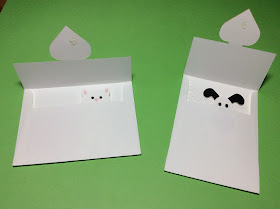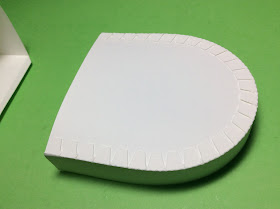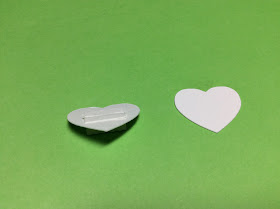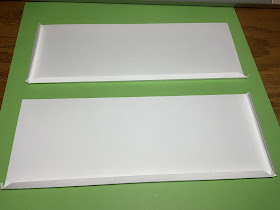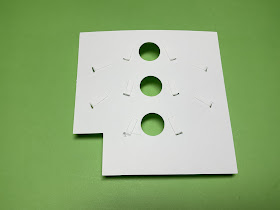Eight 1 inch green cubes, shown in the top row, are placed inside the 2 inch cube. The cumulative enclosed volume is calculated.
Eight multicolored colored cubes, shown in the second row, are nested inside of one another starting at the smallest cube and the cumulative enclosed volume is calculated.
In this blog posting, I compare the cumulative enclosed volume of two 2 inch cubes. The cubes were made using SNAP! SNAP! is a block based programming language which creates files in SVG format to be opened in the Silhouette software for cutting. For my Silhouette paper cutting friends, no coding is necessary as I have provided the .Studio files for making these boxes.
For those of you who would like to see my code or modify it, here is my code in SNAP! The program is dynamic because it allows the user to modify the size of the box - length and width, the height of the box top, the tab width and the percentage the box bottom is decreased in reference to the top of the box.
To make the green cubes, eight 1 inch cubes and one 2 inch cubes are cut, constructed and placed inside of the 2 inch cube. The one inch cubes are really 0.9 inches to allow for paper allowance but for simplicity sake, use the value of 1 inch for calculations.
To make the multicolored cubes, eight cubes are cut, constructed and nested inside of one another starting at the 0.25 inches cube to the 2 inch cube. Each box increases in size by 0.25 inches.
Here is the PDF. I used 65 lb. cardstock.
Here is the .Studio file.
Here is the SVG. Zoom out as the file extends outside the viewable area.
Comparing the Cumulative Enclosed Volume of Two Cubes
Here are two 2 inch cubes.
Can you calculate the volume of each of these cubes?
Volume is defined as the space that a three dimensional object occupies expressed in cubic units.
The formula for volume is:
Volume = Side x Side x Side
The answer is 2 x 2 x 2 = 8 cubic inches
What happens to the volume of the cube if I put something inside these cubes. The volume of the cube is reduced when something is placed inside it. The volume is the amount of space it takes up. If you place an object inside of a cube, it will occupy some of the space within the cube, thus reducing the volume.
Enclosed volume refers to the amount of space that is completely surrounded by a solid object. It is the volume of the interior of an object and is the space that is available to be filled with a substance or an object. For example, putting a cube inside of the 2 inch cube and calculating the volume of each individual 1inch cube inside gives you the enclosed volume.
Cumulative enclosed volume refers to the total volume that is contained within a set of nested objects. This can be done by adding up the volumes of each of the individual objects. The cumulative enclosed volume is a measure of the total amount of space occupied by a set of objects.
Can I increase the cumulative enclosed volume if I place more cubes inside? Yes.
If I told you that one cube has eight cubes in it and the other has seven cubes in it, could you tell me which cube has more cumulative enclosed volume? No because the sizes of the cube might be different.
If I let you peak inside can you tell which cube has more cumulative enclosed volume? Not really.
The green 2 inch cube has eight cubes which have a side length of 1 inch. What is the enclosed volume of the eight 1 inch cubes?
1in x 1in x 1in = 1 cubic inch
1 cubic inch x 8 cubes = 8 cubic inches of enclosed volume
When I add the volume of the two inch cube, which was 8 cubic inches (calculated previously) to the enclosed volume of the 8 cubes, I get the cumulative enclosed volume of 16 cubic inches.
Here are eight nested cubes which increase in size by 0.25 inches from 0.25 inches to 2 inches.
What is the cumulative enclosed volume of all of these cubes?
0.25 in x 0.25 in x 0.25 in = 0.015 cubic inch
0.5 in x 0.5 in x 0.5 in = 0.125 cubic inch
0.75 in x 0.75 in x 0.75 in = 0.42 cubic inch
1 in x 1 in x 1 in = 1 cubic inch
1.25 in x 1.25 in x 1.25 in = 1.95 cubic inch
1.5 in x 1.5 in x 1.5 in = 3.38 cubic inch
1.75 in x 1.75 in x 1.75 in = 5.36 cubic inch
2 in x 2 in x 2 in = 8 cubic inch
For a total of 20.25 cubic inches of cumulative enclosed volume.
Comparing the two sets of cubes, the green set of cubes has a cumulative enclosed volume of 16 cubic inches and the multicolored set of cubes has a cumulative enclosed volume of 20.25 cubic inches.








